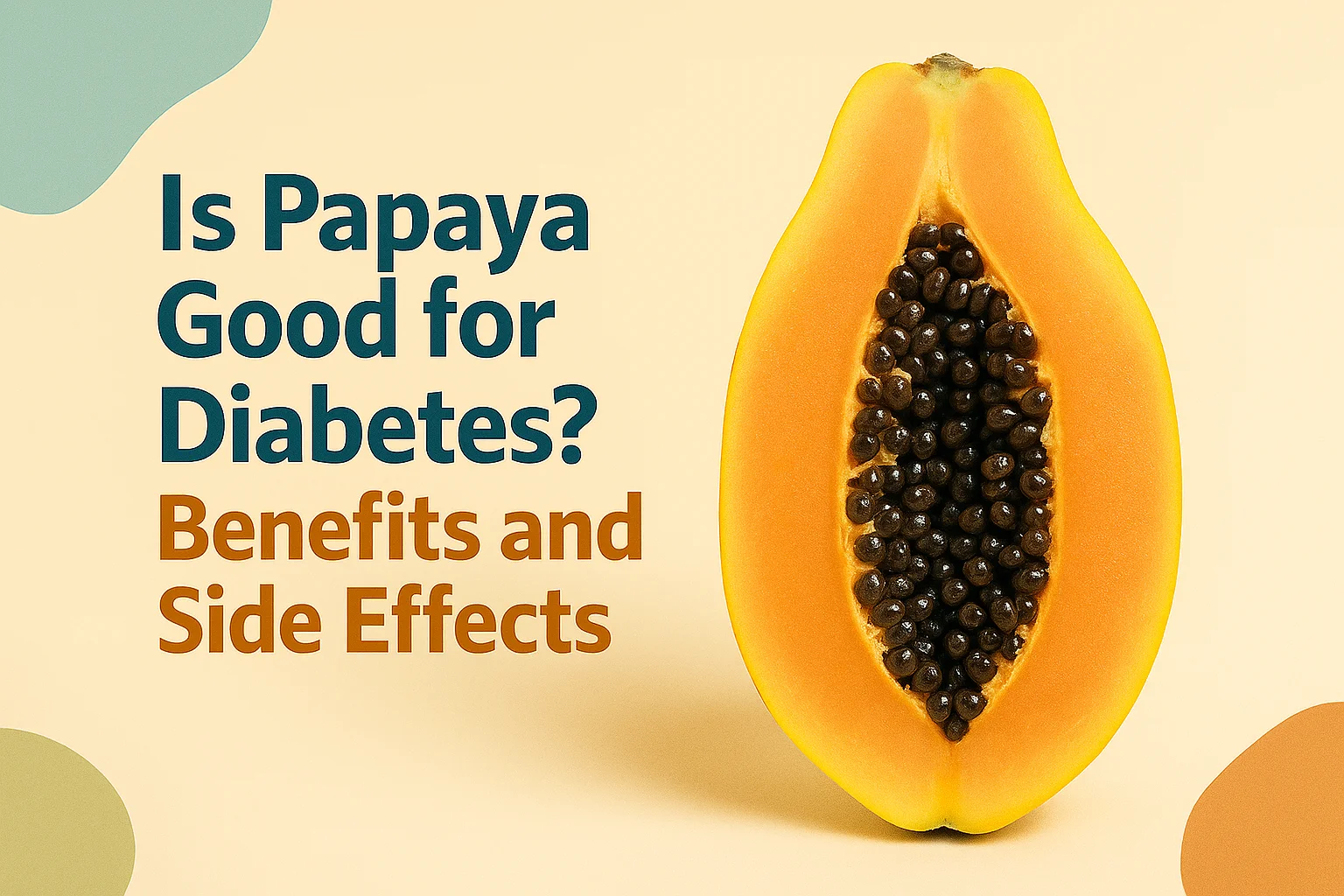Managing diabetes isn’t just about taking medication—it’s also about making informed choices about what you eat. Fruits are an essential part of a balanced diet, but for people with diabetes, the natural sugar content in fruits often raises questions. One common question is: is papaya good for diabetes?
Let’s dive deep into the benefits and possible side effects of papaya for diabetic individuals and explore whether it deserves a place in your diabetes-friendly diet.
Understanding Diabetes and Diet
Before we get into papaya, it’s important to understand how diabetes affects your body. Diabetes is a metabolic condition where your body either doesn’t produce enough insulin (Type 1) or becomes resistant to insulin (Type 2), causing elevated blood sugar levels.
Your diet plays a crucial role in managing blood sugar. High-fiber, low-glycemic-index foods help regulate glucose levels, while sugary, high-carb foods can spike them. That brings us to the key question: is papaya good for diabetes, or should it be avoided?
Nutritional Profile of Papaya
To understand its role in diabetes, let’s look at the nutritional breakdown of papaya per 100 grams:
- Calories: 43
- Carbohydrates: 11 grams
- Sugars: 7.8 grams
- Fiber: 1.7 grams
- Vitamin C: 75% of the Recommended Daily Allowance (RDA)
- Vitamin A, E, folate, magnesium, and potassium
Though it contains natural sugars, papaya is low in calories and high in fiber and antioxidants, which are beneficial for diabetic patients.
Is Papaya Good for Diabetes? The Glycemic Index Perspective
The glycemic index (GI) is a number that tells you how fast a food can raise your blood sugar. Papaya has a low GI of 60 (on a scale of 0–100). Foods with a GI less than 55 are considered low, while 56–69 is moderate, and 70+ is high.
So, even though papaya has some natural sugars, it does not spike blood sugar drastically. This makes the answer to is papaya good for diabetes lean toward a yes—when consumed in moderation.
Health Benefits of Papaya for People with Diabetes
1. Helps Control Blood Sugar Levels
Papaya has a moderate glycemic index (GI) meaning it doesn’t raise blood sugar levels too quickly. Additionally, it’s rich in dietary fiber which slows down the digestion and absorption of sugar into the bloodstream. This helps in preventing sudden spikes and crashes in blood sugar—an essential part of managing diabetes.
For example: A diabetic individual replacing high-sugar desserts or snacks with a small bowl of ripe papaya can enjoy a sweet treat without significantly impacting their glucose levels. Over time, this simple dietary change can lead to better blood sugar management and improved insulin sensitivity.
2. Rich in Antioxidants
Another compelling reason why is papaya good for diabetes gets a “yes” is because of its antioxidant content. Papaya is loaded with vitamin C, beta-carotene, and flavonoids—natural compounds that protect your body from oxidative stress. Diabetics often experience high oxidative stress, which can lead to complications like nerve damage, heart issues, and kidney problems.
Including antioxidant rich foods like papaya in your diet helps neutralize harmful free radicals, thus reducing the risk of long term complications related to diabetes. This makes papaya not just a sugar-friendly fruit but also a protective one.
3. Boosts Immunity
For people living with diabetes, weakened immunity is a common concern. High blood sugar can lower the body’s ability to fight off infections, making you more prone to colds, flu, and even delayed wound healing. Here’s where the question “is papaya good for diabetes” gains another positive answer—papaya is extremely rich in vitamin C, a nutrient known for strengthening immune function.
Just 100 grams of papaya can provide over 70% of your daily recommended intake of vitamin C. Regular consumption can help you build resistance against everyday infections, making it easier for diabetics to stay healthy year-round.
4. Improves Digestive Health
Another indirect yet valuable reason why the answer to “is papaya good for diabetes” is yes—its ability to support digestion. Papaya contains an enzyme called papain, which aids in breaking down proteins and supports smoother digestion. Many diabetic individuals face digestive issues like bloating, indigestion, or irregular bowel movements due to dietary changes or medications.
Adding papaya to your diet can ease these symptoms, improve nutrient absorption, and help regulate your digestive system. A healthy gut also contributes to more balanced blood sugar levels making this fruit a holistic support for diabetes management.
5. Supports Eye Health
One of the less known benefits is its positive impact on vision. Diabetics are at a higher risk of developing eye related issues such as diabetic retinopathy and macular degeneration. Papaya is a rich source of vitamin A and lutein—nutrients essential for eye health and vision protection.
By regularly eating papaya, individuals with diabetes can nourish their eyes and possibly reduce the risk of vision loss associated with the condition. It’s a small dietary step that supports a very important aspect of long-term diabetic health.
Also Read: Dry Fruits for Diabetic Patients
How Much Papaya is Safe for Diabetics?
Moderation is key. A serving size of ½ cup to 1 cup of fresh papaya per day is generally safe for people with diabetes. This provides essential nutrients without leading to blood sugar spikes.
Avoid overconsumption, especially if you’re eating other high-carb fruits the same day.
A sample inclusion in a diabetic diet:
- Breakfast: Oats with cinnamon and chia seeds
- Mid-morning snack: ½ cup papaya slices
- Lunch and Dinner: Balanced with whole grains, lean protein, and vegetables
How to Eat Papaya for Diabetes
- Choose ripe, fresh papaya: Avoid overripe ones, which have more sugars.
- Pair with protein or fiber: Combine papaya with yogurt or nuts to slow sugar absorption.
- Avoid dried or candied papaya: These are loaded with added sugars and not recommended.
- Monitor portion size: Even healthy fruits should be consumed mindfully.
These guidelines help answer not only is papaya good for diabetes but also how it should be eaten to maximize benefits.
Side Effects and Precautions
While papaya is generally safe for diabetics, there are a few caveats:
1. Excess Sugar Intake
While papaya has a moderate glycemic index and is considered a safe fruit for diabetics, consuming it in large quantities—especially as juice or smoothie—can lead to too much natural sugar in the body. Juicing papaya removes most of its fiber, which otherwise helps slow down sugar absorption. Without fiber, the sugars enter your bloodstream more quickly, which can spike glucose levels.
So, if you’re wondering is papaya good for diabetes, the answer is yes—but only when eaten in moderation. Avoid drinking large glasses of papaya juice or over-snacking on it in one sitting.
2. Papaya Allergies
Another concern while considering papaya for diabetes is the possibility of an allergic reaction. Some individuals may be allergic to papain, an enzyme naturally found in papaya. Symptoms may include skin rashes, itching, stomach discomfort, or in rare cases, difficulty breathing.
If you’ve never eaten papaya before or have allergies to similar tropical fruits or latex, it’s best to start with a small portion and watch for any reactions. Allergies are uncommon but worth noting for those with sensitive systems.
3. Interaction with Medications
If you are managing diabetes with medications, especially blood thinners or insulin-regulating drugs, papaya could potentially interfere with how these drugs work. Papaya is known to have a mild blood-thinning effect and could enhance the action of anticoagulants like warfarin.
That’s why, even though papayas are good for diabetes, it’s important to consult your healthcare provider before consuming papaya in large or frequent quantities. Your personal health condition, current medications, and dosage levels matter when introducing any new fruit into your diet regularly.
What Do Experts Say?
Nutritionists often recommend low-to-moderate-GI fruits like papaya to diabetics as part of a well-rounded diet. A study published in the Journal of Food Science and Technology showed that papaya has anti-inflammatory properties and may assist in metabolic regulation.
Doctors usually advise people with diabetes to eat a variety of fruits and monitor blood glucose levels regularly. Including papaya in this rotation can provide multiple benefits if done wisely.
Also Read: Diet Plan for Diabetes Patients
Real-Life Example
Let’s take an example of Rajesh a 50 year old man with Type 2 diabetes. His nutritionist replaced his morning sugary snack with half a bowl of papaya. Within three months, not only did his fasting sugar improve but he also reported better digestion and energy levels.
Rajesh’s experience answers the question: is papaya good for diabetes with real-world evidence—it’s not just about science, it’s also about lifestyle results.
Should You Include Papaya in a Diabetic Diet Plan?
Yes, but smartly.
- Choose ripe but not overly soft papaya
- Eat in small portions
- Pair with fiber or protein
- Avoid papaya juice or dried papaya
- Track your blood sugar responses
Doing so will help you enjoy the benefits of papaya while keeping your diabetes under control.
Also Read: Easy Tips to Stay Healthy Every Day
Conclusion
So, is papaya good for diabetes? The answer is a yes—with moderation and mindfulness.
Papaya offers multiple health advantages for people with diabetes, including blood sugar regulation, antioxidant protection, improved digestion, and better immunity. But portion control and overall diet quality still matter.
Like any food, papaya is not a miracle cure but can be a valuable part of your diabetes-friendly meal plan when eaten wisely.
Frequently Asked Questions
1. Is papaya high in sugar for diabetics?
No, papaya contains natural sugars but in moderate amounts. One cup has around 8 grams of sugar, which is lower compared to many other tropical fruits.
2. Can diabetics eat papaya daily?
Yes, diabetics can eat small amounts (½ to 1 cup) of papaya daily, depending on individual blood sugar levels and dietary plan.
3. Does papaya spike blood sugar?
Due to its moderate glycemic index and high fiber, papaya doesn’t cause rapid blood sugar spikes when eaten in recommended portions.
4. Is papaya better than bananas for diabetics?
Yes, generally. Papaya has a lower glycemic load and sugar content than bananas, making it more diabetes-friendly.
5. What is the best time to eat papaya for diabetes?
Morning or as a mid-morning snack is ideal. Avoid eating it late at night or immediately after a high-carb meal.




